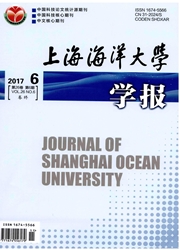

 中文摘要:
中文摘要:
从已获得的3种坛紫菜优质高产品系中,筛选出耐低盐的优良品系YZ-7。各品系的壳孢子在正常盐度(26‰)下培养35d后长成较大的苗,然后用取孔器分别获得叶片的圆盘体,把后者培养在不同盐度下进行叶片生长试验。在26‰ 、15‰、8‰、5‰和3‰五种不同盐度下培养15d,YZ-7品系的圆盘体平均直径分别增加了18、14.3、3.9、2.8和0.6倍,而野生型(胛)品系的圆盘体平均直径分别只增加了1.7、1.5、0.4、0.25和0倍。由此可见,无论是在高盐还是在低盐条件下,YZ-7品系的叶片生长均远快于时品系。把各品系的壳孢子在正常盐度下长成的大叶状体用海螺酶分解,获得大量的单离体细胞,再将后者分别培养在不同的盐度下进行耐低盐实验。在3‰的盐度下培养15d,优良品系YZ-7的细胞成活率高达58%,而时品系在此盐度下培养12d就全部死亡。在8‰和5‰下培养15d,YZ-7品系的细胞成活率分别高达78.6%和77.1%,细胞分裂率分别为100%和98.9%;而胛品系的细胞成活率分别只有36.4%和8.4%,细胞分裂率分别为88.6%和81.8%,YZ-7品系的细胞成活率和分裂率均远高于胛品系。上述实验结果初步证实优良品系YZ-7品系是耐低盐的。
 英文摘要:
英文摘要:
In this paper, it was verified that the improved variety (YZ-7) obtained previously in our lab is a low-salinity-resistant strain. The blade discs, which were cut out with a borer from the gametophytic blades developed from the conchospores of the wild type strain (WT) and three improved strains ( YZ-2, YZ-6 and YZ-7) after being cultured at the salinity of 26‰ for 35 days, were cultured in the culture medium containing of different salinity to test their growth. After being cultured at the salinity of 26, 15, 8 , 5 and 3‰ for 15 days, respectively, the mean diametric size of the blade discs of YZ-7strain increased by 18, 14.3, 3.9, 2.8and 0.6 times, while the mean diametric size of the blade discs of WT strain only increased by 1.7, 1.5, 0.4, 0.25 and 0 times compared with the original diameter, respectively. This result indicated that the YZ-7 strain grew much faster than the WT strain at either high salinity or low salinity. A large number of single somatic cells were enzymatically isolated from the big blades developed from the conchospores of the above strains, and were cultured at different salinity to test their resistance to low-salinity. After 15 days of culture at 3‰, the cell survival rate of YZ-7 strain was 58%, while the cells of WT strain died off after 12 days of culture at 3‰. After culture of 15 days at 8‰ and 5‰, the cell survival rate of YZ-7 strain was 78.6% and 77.1%, and the cell division rate was 100% and 98.9%, respectively, while the cell survival rate of WT strain was only 36.4% and 8.4%, and the cell division rate was 88.6% and 81.8%, respectively. Both of the survival and division rates of cells of YZ-7 strain were much higher than those of WT strain. These results verified that YZ-7 strain is resistant to low-salinity.
 同期刊论文项目
同期刊论文项目
 同项目期刊论文
同项目期刊论文
 Genetic analysis of the position of meiosis in Porphyra haitanensis Chang et Zheng (Bangiales, Rhodo
Genetic analysis of the position of meiosis in Porphyra haitanensis Chang et Zheng (Bangiales, Rhodo 期刊信息
期刊信息
